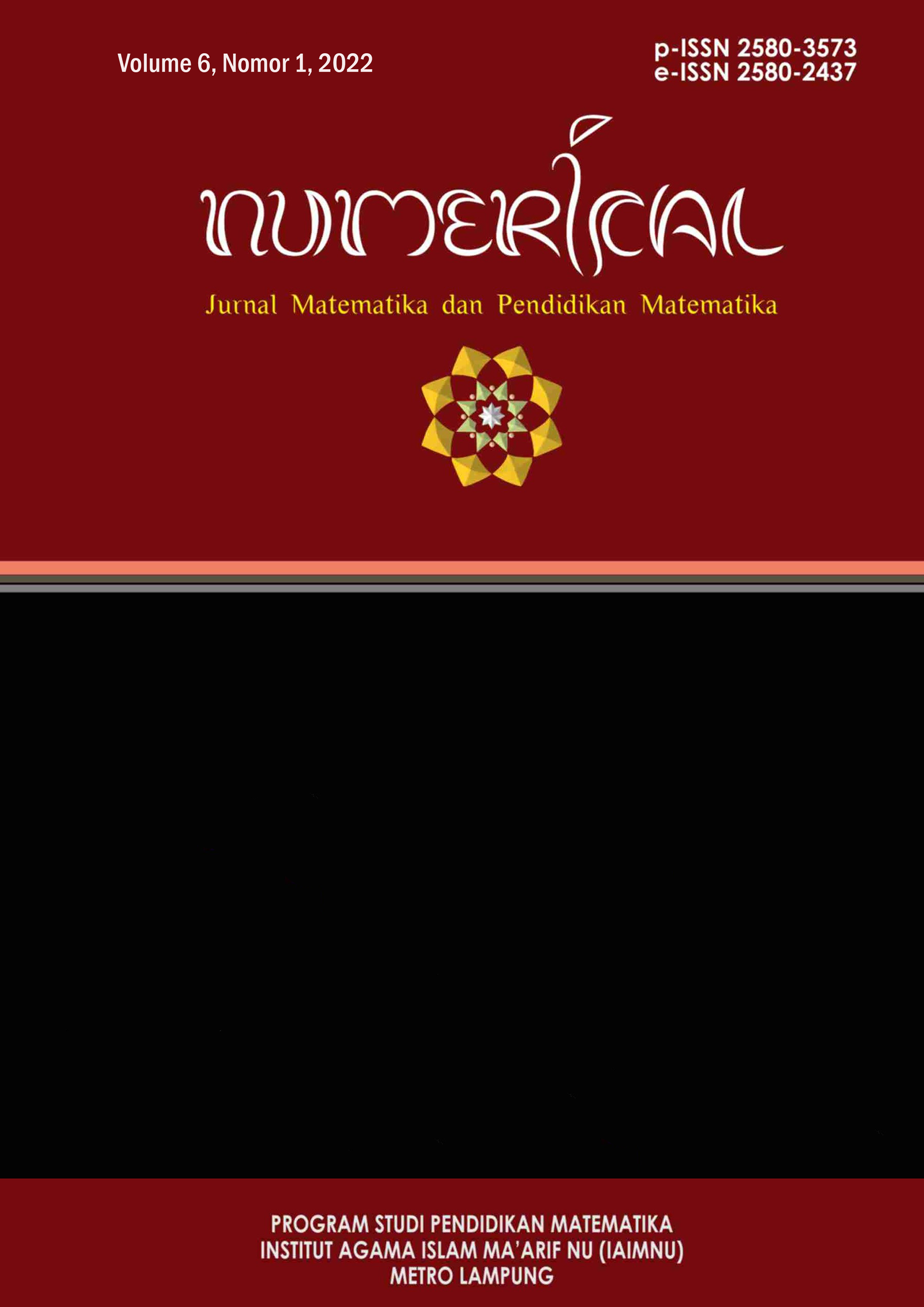Optimization of Teak Wood Furniture Production Using Linear Programming Method at Sumenep East Java Indonesia
DOI:
https://doi.org/10.25217/numerical.v6i1.2325Keywords:
Optimization, Furniture Production, Teak WoodAbstract
3R Furniture company produces some products i.e. doors, chairs, cabinets, tables and frames. This company has some problems about maximize the production and minimize the cost of production. The 3R furniture company has not managed demand properly because it has not been able to synchronize the company's available resources with fulfilling consumer demand. This study aims to determine the amount of production produced by the "3R" Furniture Company by utilizing available resources and to find out the maximum profit obtained by the "3R" Furniture Company in Sumenep Regency. This research was carried out at the "3R" Furniture Company in Sumenep Regency, especially on Kangean Island. Linear programming is a model of operational research that usually used to solve optimization problem. The simplex method is a method that can be used in linear programming which serves to find solutions optimal. The purpose of this research is to optimize the benefits of 3R Furniture company. The respondents consisted of 4 people, namely 1 business owner and 3 labor representatives from the "3R" Furniture business. The results showed that the number of products produced to obtain maximum profit was 30 units of tables by utilizing existing resources. The maximum profit by producing a table is Rp. 20999.998.
References
C. S. Efendi, D. D. Pratiknyo, and I. E. Sugiono, Perpustakaan Nasional RI : Katalog Dalam Terbitan Susunan Tim Penyusun. .
A. Farag, S. Al-Baiyat, and T. C. Cheng, “Economic load dispatch multiobjective optimization procedures using linear programming techniques,” IEEE Trans. Power Syst., vol. 10, no. 2, pp. 731–738, May 1995, doi: http://dx.doi.org/10.1109/59.387910. DOI: https://doi.org/10.1109/59.387910
M. de Paly, J. Hecht-Méndez, M. Beck, P. Blum, A. Zell, and P. Bayer, “Optimization of energy extraction for closed shallow geothermal systems using linear programming,” Geothermics, vol. 43, pp. 57–65, Jul. 2012, doi: http://dx.doi.org/10.1016/j.geothermics.2012.03.001. DOI: https://doi.org/10.1016/j.geothermics.2012.03.001
P. C. Kuo, R. A. Schroeder, S. Mahaffey, and R. R. Bollinger, “Optimization of operating room allocation using linear programming techniques,” J. Am. Coll. Surg., vol. 197, no. 6, pp. 889–895, Dec. 2003, doi: http://dx.doi.org/10.1016/j.jamcollsurg.2003.07.006. DOI: https://doi.org/10.1016/j.jamcollsurg.2003.07.006
S. Christian, “Penerapan Linear Programming untuk Mengoptimalkan Jumlah Produksi dalam Memperoleh Keuntungan Maksimal pada CV Cipta Unggul Pratama,” The Winners, vol. 14, no. 1, p. 55, 2013, doi: http://dx.doi.org/10.21512/tw.v14i1.645. DOI: https://doi.org/10.21512/tw.v14i1.645
T. Chandra, “Penerapan Algoritma Simpleks dalam Aplikasi Penyelesaian Masalah Program Linier,” J. TIMES, vol. IV, no. 1, pp. 18–21, 2015, http://ejournal.stmik-time.ac.id/index.php/jurnalTIMES/article/viewFile/216/85.
A. Saryoko, “Metode Simpleks dalam Optimasi Hasil Produksi,” J. Informatics Educ. Prof., vol. 1, no. 1, pp. 27–36, 2016.
A. Muslimat, R. Pratama, and G. Ramayanti, “Implementasi Linear Programming Untuk Memaksimalkan Keuntungan Implementasi Linear Programming Untuk Memaksimalkan Keuntungan,” November 2017, pp. 183–189, 2018.
S. Aprilyanti, I. Pratiwi, and M. Basuki, “Optimasi Keuntungan Produksi Kemplang Panggang Menggunakan Linear Programming Melalui Metode Simpleks,” Semin. dan Konf. Nas. IDEC, no. May, 2018.
L. Hakim, H. Paramu, and E. B. Gusminto, “Penerapan Linear Programming Dalam Penentuan Kombinasi Produk Guna Memaksimalkan Laba Pada Ud Putera Sroedji Jember,” Bisma, vol. 12, no. 3, p. 300, 2018, doi: http://dx.doi.org/10.19184/bisma.v12i3.9000. DOI: https://doi.org/10.19184/bisma.v12i3.9000
D. R. Indah and P. Sari, “Penerapan Model Linear Programming Untuk Mengoptimalkan Jumlah Produksi Dalam Memperoleh Keuntungan Maksimal (Studi Kasus pada Usaha Angga Perabot),” J. Manaj. Inov., vol. 10, no. 2, pp. 98–115, 2019, http://www.jurnal.unsyiah.ac.id/JInoMan.
M. Hilman, “Optimasi Jumah Produksi Produk Furniture Pada Pd . Surya Mebel Di Kecamatan Cipaku Dengan Metode Linier Programming,” vol. 03, no. 01, pp. 85–97, 2016.
H. Rusdiana, P. H. Moh Ali Ramdhani, and M. Guru Besar UIN Sunan Gunung Djati Bandung, Penerbit CV Pustaka Setia Bandung. 2014.
R. Alterovitz, E. Lessard, J. Pouliot, I.-C. J. Hsu, J. F. O’Brien, and K. Goldberg, “Optimization of HDR brachytherapy dose distributions using linear programming with penalty costs,” Med. Phys., vol. 33, no. 11, pp. 4012–4019, Oct. 2006, doi: http://dx.doi.org/10.1118/1.2349685. DOI: https://doi.org/10.1118/1.2349685
R. H. Bartels and G. H. Golub, “The simplex method of linear programming using LU decomposition,” Commun. ACM, vol. 12, no. 5, pp. 266–268, May 1969, doi: http://dx.doi.org/10.1145/362946.362974. DOI: https://doi.org/10.1145/362946.362974
M. E. Lalami, V. Boyer, and D. El-Baz, “Efficient Implementation of the Simplex Method on a CPU-GPU System,” in 2011 IEEE International Symposium on Parallel and Distributed Processing Workshops and Phd Forum, May 2011, pp. 1999–2006, doi: http://dx.doi.org/10.1109/IPDPS.2011.362. DOI: https://doi.org/10.1109/IPDPS.2011.362
J. A. J. Hall, “Towards a practical parallelisation of the simplex method,” Comput. Manag. Sci., vol. 7, no. 2, pp. 139–170, Apr. 2010, doi: 10.1007/s10287-008-0080-5. DOI: https://doi.org/10.1007/s10287-008-0080-5
D. Gale, “Linear Programming and the Simplex Method, Volume 54, Number 3.”
J. C. Nash, “The (Dantzig) simplex method for linear programming,” Comput. Sci. Eng., vol. 2, no. 1, pp. 29–31, 2000, doi: http://dx.doi.org/10.1109/5992.814654. DOI: https://doi.org/10.1109/5992.814654
H. M. V. Samani and A. Mottaghi, “Optimization of Water Distribution Networks Using Integer Linear Programming,” J. Hydraul. Eng., vol. 132, no. 5, pp. 501–509, May 2006, doi: http://dx.doi.org/10.1061/(ASCE)0733-9429(2006)132:5(501). DOI: https://doi.org/10.1061/(ASCE)0733-9429(2006)132:5(501)
Downloads
Published
How to Cite
Issue
Section
License
Copyright (c) 2022 Siti Nurul Afiyah, M. Syaifuddin, Nur Lailatul Aqromi

This work is licensed under a Creative Commons Attribution-ShareAlike 4.0 International License.







